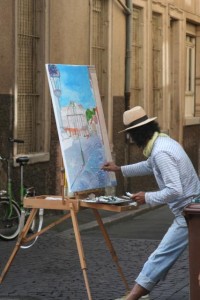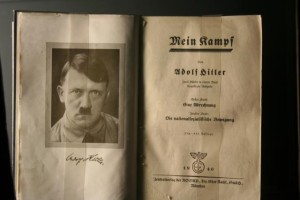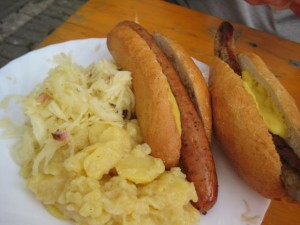Mon 21 Jul 2008
Bavarian Summer
Posted by Derek under Germany
[2] Comments

After fueling up our car (See Note re: Gas Prices below), we crossed the border out of Luxembourg and into Germany. While many visitors to Germany focus on the larger cities, mainly Munich and Berlin, we decided to spend our few days in the country in the smaller villages and cities in the southern region of the country. We followed small country roads in the southwestern part of Germany that passed through villages that seemed to have changed very little over the past hundred years, with names that didn’t make our guidebook or our map.
We then drove down the Rhine Route, a small road heavily promoted by the German tourist board that follows the Rhine river south for a couple of hours. While the drive brought up fond memories of a Rhine river cruise I did during a mad-dash tour of Europe in 1993, the scenery was somewhat disappointing because the river was full of tourist boats and the supposedly quaint towns along the way were far from quaint, with the streets full of gift shops selling “authentic” German wares lovingly made in China.

Heidelberg was our next stop, though, and it turned out to be gorgeous. Home to the oldest (founded in 1387) and arguably the best university in Germany, this vibrant town is full of ancient churches and is watched over by a large castle. When Mark Twain took his family on a trip to Europe in 1878, his first stop was in Heidelberg, where he intended to stay for just a day or two. Instead, the allure of the city (which some attribute to the name Heidelberg, which means “Huckleberry Mountain”) kept him here for three months. We can see why.

Our next stop was Nuremberg, known now as the city that hosted the Nuremberg Trials for Nazi war criminals after World War II. The city was chosen as a host because it was the centerpiece of Nazi activity. Hitler built huge Nazi Party rally grounds here, and hundreds of thousands of Germans gathered upon them to see the Fuhrer and to be indoctrinated with Nazi-inspired hate. A fascinating museum, outlining Nazi history and the building of the rally grounds, was well worth our stop and provided us with a greater understanding of the atmosphere in Germany in the 1930s that led to one of the most tragic times in history.
We spent our last couple of days in Germany in the heart of Bavaria, a large region in southeastern Germany that is famed for its forests and mountains. We based ourselves in Regensberg, another university town we’d never heard of. It turned out to be a gorgeous, cafe-filled city that was as vibrant as any we’ve seen anywhere. It seemed that every resident of this ancient city (which is well over 2,000 years old) lived life outside, walking the streets and lounging in the outdoor cafes.

From Regensberg, we took day trips to a few small villages near the Danube River, two of which (Kreistadt and Eichstatt) were having their local summer festivals on the day we visited. These festivals, put on solely for the local community and devoid of the truckloads of tourists that you’ll see at larger festivals such as Octoberfest in Munich, were full of families enjoying the summer weather, the German music, the delicious sausages and the German obsession – beer.  I took the opportunity to play chess against a hot-shot teenager who thought he was so impressive that he had set up a few tables and was playing 5 games of chess simultaneously. He crushed me in about 2 minutes.

Part of the Kriestadt festival included a sort of variety show wherein local dance classes performed that year’s routine and a folk-singing group did some sort of square dance. We’d seen the same kind of stuff at home, but imagine our surprise when a bit of home came to us. All of the sudden, a group of high school kids from Edmon, Oklahoma (presumably students from a German class on their summer trip abroad) took to the stage and lackadaisically began doing the Macarena and an equally horrifying dance number to a medley of last year’s hip-hop favorites. (Surely they were forced by their German teacher to embarrass themselves in this way.) I think we’ll stop laughing about these poor kids in the next decade or so.
GAS PRICES: If you think it’s bad in America right now with gas selling for over $4 a gallon, try driving in Europe! We’ve been paying between $7.40 and $8.30 a gallon since we’ve been here. Filling up the tank is simply painful. Gas has historically been much higher in Europe in America. Accordingly, most Europeans drive very small, gas-efficient cars – seeing an SUV or truck in Europe is a rare occurrence. It will be interesting to see what America’s cars look like 10 years from now.
[embedplusvideo height=”350″ width=”450″ editlink=”http://bit.ly/1r6fPFF” standard=”http://www.youtube.com/v/xTZdWRAuOTg?fs=1″ vars=”ytid=xTZdWRAuOTg&width=450&height=350&start=&stop=&rs=w&hd=0&autoplay=0&react=1&chapters=¬es=” id=”ep5836″ /]